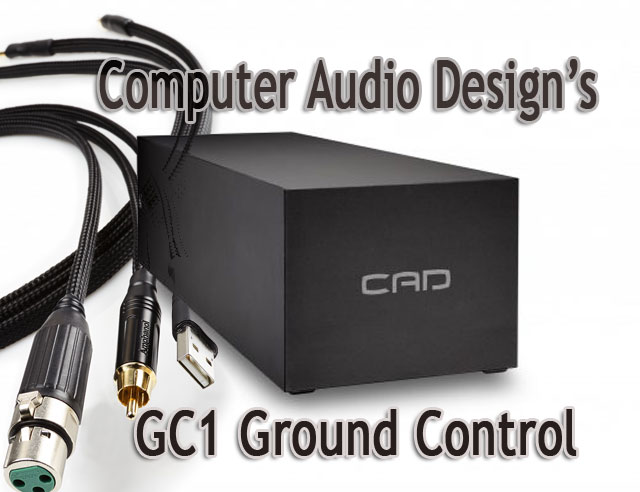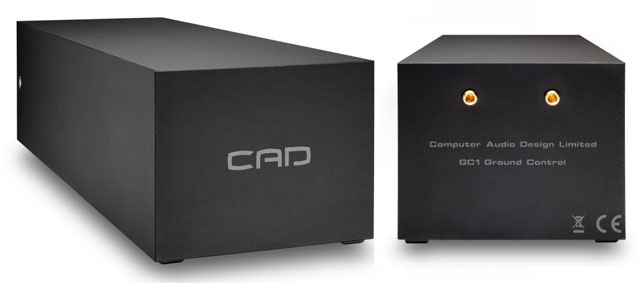CAD GC1 Ground Control

 I’ll come right out and say it: I did not expect what I heard after placing Computer Audio Designs’s (CAD) GC1 Ground Control in system. I coupled it to an available coaxial RCA jack on the Arcam irDAC ll, connected with Oyaide cables and interconnects to the Parasound Halo 2.1 Integrated amplifier and out to my Eminent Technology LFT-8b’s and sat back with the MacBook Pro for a critical first listen to some familiar tracks. The GC1 Ground Control did not disappoint.
I’ll come right out and say it: I did not expect what I heard after placing Computer Audio Designs’s (CAD) GC1 Ground Control in system. I coupled it to an available coaxial RCA jack on the Arcam irDAC ll, connected with Oyaide cables and interconnects to the Parasound Halo 2.1 Integrated amplifier and out to my Eminent Technology LFT-8b’s and sat back with the MacBook Pro for a critical first listen to some familiar tracks. The GC1 Ground Control did not disappoint.
I’ve been walking around grounding products for a couple of years now, trying a few here and there. I can’t say that I’ve really heard the benefits from some of the affordable ones when placed in my system and it’s been a frustrating admission. Plug in, listen for a while, pull out, listen, repeating the exercise ad nauseum… trust me, I’ve tried. Clement has numerous Entreq devices in his system and that rig sounds so good, that all of this has left me feeling decidedly left out, until now – enter the CAD GC1 Ground Control.
Not only did the GC1 provide a deeper and wider soundstage, there were sharper leading edges to transients allowing a greater contrast in dynamics. It felt like the music file was of greater resolution, as though my lossless CD rips were higher resolution downloads. Instruments sounded better fleshed out, percussive accents were crisper and more dynamic and these familiar recordings possessed a new vitality that I actually felt like recordings were ones I have yet to experience.
As I moved from track to track, I found myself raising the listening volume, allowing the instruments to emerge out of a greater blackness, thanks to the GC1. I was taken with the deeper, more enveloping soundstage and the added definition of each instrument. Phrases didn’t collapse within dense or dynamic passages, horns possessed a more authoritative sonority and percussion appeared built from a broader palette from which to describe texture. Timing also improved, injecting worthy tracks a greater sense of rhythmic.
As the GC1 did it’s magic, the soundstage pushed farther back allowing the drums and cymbals to better define the boundaries of the recording venue, which seemed to have expanded, with prior perceptions of the space pushed further outward. This listener was rewarded with a view closer to the center of the recording.
Music sounds more effortless and relaxed, thanks to the GC1 providing better pacing, rhythm and timing. Upright basses, to this ear, sounded far better defined – rounder, more textural and with better body.
Music used during review:
Tord Gustavsen Quartet ‘The Well’ (2012 ECM Records)
Brian Blade Fellowship ‘Perceptual’ (2000 Blue Note)
Rickie Lee Jones ‘Pop Pop’ (1991 Geffen)
Billy Childs ’Map to the Treasure: Reimagining Laura Nyro’ (2014 Sony Masterworks)
Anouar Brahem ‘Barzakh’ (1991 ECM Records)
Anthony Wilson ‘Jack Of Hearts’ (2009 Groove Note)
Cassandra Wilson ‘Traveling Miles’ (1999 Blue Note)
Gateway ‘Gateway 2’ (1977 ECM Records)

The CAD GC1 Ground Control
The GC1 weighs in at a heft 10.25 lbs for it’s 12.625” L X 4.37” W X 3.5” H size. CAD describes the simple matte black unit as a noise reduction device that improves performance of the digital audio by reducing high frequency noise on signal and earth grounds, audibly improving sound quality. The CAD website notes that the GC1 is made up of a variety of materials that convert high frequency energy into heat (properly dissipating this energy without adversely affecting the audio signal). CAD notes that this reduction is quite dynamic, such that many listeners perceive an increase in resolution and musicality when the GC1 is in use… I certainly did.
CAD says the “GC1 Ground Control can be connected to any audio product that has an unused output or input connection. If your DAC, streamer, computer, phone stage, preamplifier, amplifier, CD Player, NAS, etc. has a spare output/input connector like an RCA, XLR, Spade, USB or Ethernet, you can connect the GC1 Ground Control to that. We supply a range of interconnects with various connectors. The other end of the interconnect has a single or double 4mm banana plug that attaches to the GC1 Ground Control.”
Continuing, “The GC1 Ground Control can also be attached to Earth. If you have any type of Earth connection on your audio system or power distribution CAD can supply you a cable with an appropriate connector that will fit. We typically get the best results connecting the GC1 Ground Control to the device in your system that has the highest noise levels. Components like computers, audio servers, DACs, CD players, NAS, routers etc. We typically get better results doing this than connecting multiple devices to the GC1. [Often] amazing results are found by connecting the GC1 Ground Control to the mains Earth.”
I took the GC1 to a different system with turntable, phono stage (under review), moving coil and tube integrated and connected it to an available jack on the phono stage. This system also benefitted from the inclusion of the CAD GC1, though the effect was more subtle than I found with the DAC. When I swopped out the phono stage and removed the GC1, I still enjoyed the system.
The Wrap
So, I finally heard things. The CAD GC1 Ground Control made a difference with DAC use that I could hear and, at times, the effect was apparent and desirable. Give the GC1 a listen for yourself, your mileage may vary.
greg voth
Specifications:
Dimensions are: 322 (L) x 111 (W) x 88 (H) mm
Weight : 4.65 Kg
Price: £1,400 (approximately $1850 USA)
Website: www.computeraudiodesign.com/ground-control/
Stereo Times Masthead
Publisher/Founder
Clement Perry
Editor
Dave Thomas
Senior Editors
Frank Alles, Mike Girardi, Russell Lichter, Terry London, Moreno Mitchell, Paul Szabady, Bill Wells, Mike Wright, and Stephen Yan,
Current Contributors
David Abramson, Tim Barrall, Dave Allison, Ron Cook, Lewis Dardick, John Hoffman, Dan Secula, Don Shaulis, Greg Simmons, Eric Teh, Greg Voth, Richard Willie, Ed Van Winkle, Rob Dockery, Richard Doron, and Daveed Turek
Site Management Clement Perry
Ad Designer: Martin Perry





Be the first to comment on: CAD GC1 Ground Control